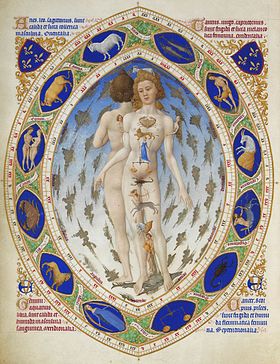Zodiac


The zodiac (from Latin/Greek Zodiakos/ζῳδιακός) comprises a zone about 20° wide around the apparent orbit of the Sun, the ecliptic, within which the movements of the Moon and the planets visible from Earth pass. Within the zodiac lie the twelve constellations that have given their names to the well-known twelve signs of the zodiac. Twelve cosmic directional forces are thereby established.
From a spiritual point of view, the zodiac is the physical expression of the first hierarchy, in particular the community of the Cherubim and Seraphim, whose dominions extend far beyond the boundaries of our solar system, whereby the Cherubim are to be addressed as the actual zodiacal beings.
The twelve signs of the zodiac
The signs of the zodiac divide the zodiac into 12 sections of exactly the same size, each 30°. At the time of their naming about 2500 years ago, the signs of the zodiac were largely congruent with the corresponding constellations, except for the different sizes of the individual constellations, which are not always exactly 30°. Due to precession, the signs of the zodiac shift in relation to the constellations by one whole sign each in about 2160 years. Only after 25920 years (= 12 x 2160) is the original state restored.
Western astrology, also called tropical astrology, is oriented towards the course of the year and continues to calculate with the original system of the zodiac signs despite the shift in relation to the corresponding constellations. The tropical zodiac begins with the vernal equinox, which is invariably equated with the beginning of the zodiac sign Aries. In fact, however, the vernal equinox today is astronomically already far in the constellation of Pisces. According to Rudolf Steiner, it had entered the constellation of Aries much earlier, namely at the beginning of the Greco-Latin period in 747 BC.
In Indian astrology, the sidereal zodiac is used. Here the signs of the zodiac are firmly bound to the constellations, which is why one speaks of sidereal astrology. In this system, the signs of the zodiac move gradually through all the seasons together with the constellations in the course of precession.
| Aries | Taurus | Gemini | Cancer | Leo | Virgo | Libra | Scorpio | Sagittarius | Capricorn | Aquarius | Pisces |
The Origin of the Zodiac
Each planetary system evolves in seven successive planetary stages of world evolution (Manvantaras), each separated from the other by a purely spiritual, externally intangible existence (Pralaya). In the course of this series of development, it rises from the planetary state to the fixed star system and at the end of the sevenfold series rises to the zodiac. At the beginning of our world system, the beings of the first hierarchy had already completed their solar development, that is, their fixed star existence. The previous world system had dissolved after its completion and had become the circumcircle, the first, albeit still completely unstructured system of a completely new zodiac, out of which our planetary system was created.
The formation of our planetary system began with the first Hierarchy seeking a suitable spherical space in the Universe (Lit.:GA 110, p. 82) and working creatively into it from outside. The Seraphim received the plans for the new world system from the Trinity. The Cherubim, who in their totality as zodiacal entities are encamped around this centre of their creative activity, continue to work out these plans, and the Thrones, by letting out their substance of will, which outwardly appears at first only as heat, made possible with the Old Saturn, the first planetary incarnation of our Earth for a first outer realisation.
The differentiated structure of the zodiac began to form during the old solar existence of our planetary system. The Cherubim appeared in very specific etheric forms, namely as winged lions, bulls, men and eagles. Each of these four cherubic forms had two accompanying forms: the bull was accompanied by Aries and Gemini, the lion by Cancer and Virgo, the eagle, which much later became Scorpio, was accompanied by Libra and Sagittarius, and the human form, which today is called Aquarius, was accompanied by Capricorn and Pisces.
The Old Sun, which at that time was not yet a true fixed star, but from an occult point of view must still be called a planet, did not yet shine continuously, but illuminated itself at periodic intervals and then sank again into darkness. During these solar nights the Cherubim formed the first plant of the physical animal forms out of the solar nebula. That is why the sphere of the Cherubim was later rightly called the zodiac.
Literature
- Gisela Gorrissen: Astrologie aus anthroposophischer Sicht. Eine Einführung, Urachhaus Vlg., Stuttgart 2000
- Rudolf Steiner: Das Hereinwirken geistiger Wesenheiten in den Menschen, GA 102 (2001) English: rsarchive.org German: pdf pdf(2) html mobi epub archive.org
- Rudolf Steiner: Ägyptische Mythen und Mysterien, GA 106 (1992) English: rsarchive.org German: pdf pdf(2) html mobi epub archive.org
- Rudolf Steiner: Das Rätsel des Menschen. Die geistigen Hintergründe der menschlichen Geschichte, GA 170 (1992) English: rsarchive.org German: pdf pdf(2) html mobi epub archive.org
 |
References to the work of Rudolf Steiner follow Rudolf Steiner's Collected Works (CW or GA), Rudolf Steiner Verlag, Dornach/Switzerland, unless otherwise stated.
Email: verlag@steinerverlag.com URL: www.steinerverlag.com. Index to the Complete Works of Rudolf Steiner - Aelzina Books A complete list by Volume Number and a full list of known English translations you may also find at Rudolf Steiner's Collected Works Rudolf Steiner Archive - The largest online collection of Rudolf Steiner's books, lectures and articles in English. Rudolf Steiner Audio - Recorded and Read by Dale Brunsvold steinerbooks.org - Anthroposophic Press Inc. (USA) Rudolf Steiner Handbook - Christian Karl's proven standard work for orientation in Rudolf Steiner's Collected Works for free download as PDF. |












